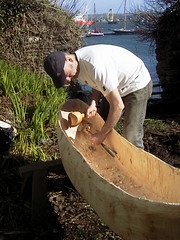
Framework of currach for Sharpham Barton camp August 2007 - sor more images see http://www.flickr.com/photos/rorymac/show/

For more images of Bristol Harbour Festival see http://www.flickr.com/photos/rorymac/983284874/
Currachs
Contact: rorymaphee@yahoo.com 07976280610
Workshop location Potager Garden High Cross Constantine

The Irish currach is an intriguing example of skin on frame boat construction techniques. The most highly evolved example of the currach is found in Kerry. Like other currachs, the hull is built around the gunwhale frame - as opposed to the keel in the Mediterranean carvel tradition.
Currach at anchor
This is a construction plan of a currach from Achill - lines liftted by Hornell...and more drawings from Hornell.
The startling feature is that, for a boat designed centuries ago, the gunwhale is an ideal low weight beam - two flanges separated by a web. The flanges are the upper and lower gunwhales, the web the stanchions/struts.
The building sequence is thus: build gunwhale frame; cut mortises for frames; steam, bend and fit oak frames; fair frames with longitudinal battens (the frames will slide in mortises); lash or fasten longitudinals to frames; cover with heavy cotton cloth; waterproof with black coal tar based coating.
See here for the most extensive information on the Kerry boats on the internet, written by Holger Lonze.
By contrast, the currachs of Donegal exhibit a more archaic tradition, using as they do hazel rods instead of sawn oak laths. Only one gunwhale is used. These currachs are nonetheless very seaworthy (I have just come across Falmouth Bay in a South Easterly 5) and - just as important - easier to build. See for here for more information from Holger. For a map of Donegal see here , and information on fishing in Donegal
Here we are launching a Donegal (Dunfanaghy) currach in Penry, June 2007. Note the wheels. Later in Falmouth Harbour, and then at Tremayne Quay after a bumby ride across the bay - though caught three mackeral. See for a slide show.
Note that there are images of a variety of skin boats. I have built many boats impatiently developing new techniques. This example was built in Porthlevan in 2005, using leylandii gunwhales and terylene skin. Note the bir-furcated and decorated bow.
For a wealth of images see Colm's page. This image really illustrates the structure. Here are the blueprints...!
For evocative historic images, see this slideshow
Currachs are very seaworthy boats. Their frugality and ease of build does not detract from their usefulness.
And St Brendan?
For information on Colm Cille see and background to one of the skippers
The key published resource is Hornell's "Currachs of Ireland" published in 1936. The book is long out of print, but a copy is in the Bartlett Library at the National Maritime Museum Cornwall. For an online version see
Anchors are called "killicks" and are worthy of study...
And here are the construction regulations for racing in the USA
Fascinating field study in Achill
PaintingSaint Efflam - a 1999 voyage
History
Seminar in 2004 - Ireland's Boating Heritage
Educational Work
Currach building affords real opportunities for learning about design and build. The student is engaged in a variety of discourses - intuitive design, materials selection, embodied energy, Celtic heritage, mass, hydrodynamics and aesthetics.
In May 2007 I built two currachs in two days with Year 9 students at Truro School - see image below and also here
For a slide show see

Video Links
http://www.youtube.com/watch?v=GL-gRUotZ0s
http://www.youtube.com/watch?v=aq1TMbvc-Ps
http://www.youtube.com/watch?v=lu-Bz6Ru_Lo
http://www.youtube.com/watch?v=9e0n3_kpE2o
http://www.youtube.com/watch?v=EJV6_EIOiao
http://www.youtube.com/watch?v=vif-0y_ekWk
http://www.youtube.com/watch?v=FChQUxTmS0k
http://www.youtube.com/watch?v=t-WGv1R4-8k
